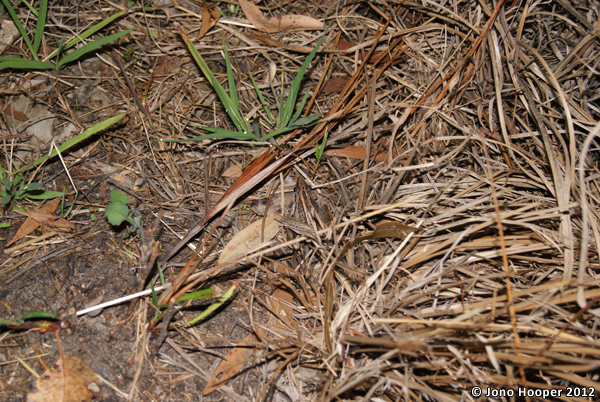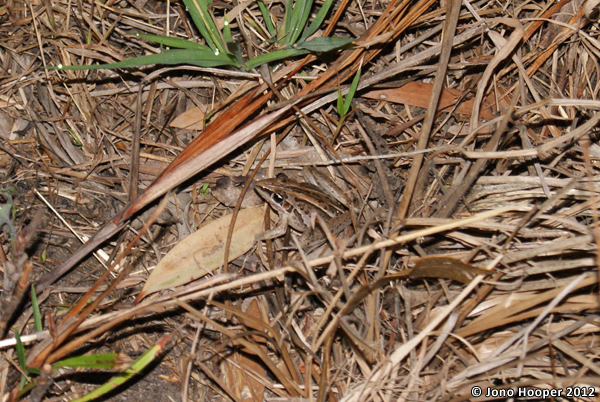Ever since a university field trip for my Urban Wildlife course to a wildlife mitigation site at Caloundra, I’ve been hanging out to come back at night. Why? Because most of the mitigation measures taken at this site were for the acid frogs, in particular Crinia tinnula (Wallum Froglet) which is endangered. The wetland habitat is surrounded by a new industrial estate and so some measures have been taken to reduce the impact, particularly road-kill of wildlife outside the wetland.
With a few showers forecast and some rain (1.5mm) that fell early in the morning, I was finally able to take up the opportunity. Being a quiet, isolated site, I thought it best to take a friend along, so I’m very grateful that Greg was able to join me. He’s a French student that is developing a taste (not in the literal sense!) for snakes.
We followed the concrete path that runs several metres in from the fence line in the wetland. At the entrance I heard Limnodynastes peronii (Striped marshfrog) calling. Along the path we spotted many cane toads, mostly juveniles. One was even lucky enough to have its photo taken (by Greg). As we’re surveying along the sides of the path I spot something jump like a flash. Missed it! A bit further on though and I’ve spotted a species on my bucket-list – Litoria nasuta (Striped Rocketfrog). Leave me alone ok – I know it’s meant to be common but I hadn’t come across one before! Species #19 found. These frogs move quick, as suggested by their name. Hence, photography was difficult! All up, we saw around 10 of this species. It wasn’t until just before we left that one of them stayed still for long enough to let me get two shots.



Being a wetland, there were many bird species we heard carrying on, as well as Tadarida australis (White-striped Free-tailed bat) – yes, I’m getting more into bats too. This species is the only of the micro-bats in this region that has a echolocation call audible to the human ear. And of course, there were lots of calling Litoria fallax (Eastern sedgefrogs), which made hearing any other species calls quite difficult.

Whilst we were frogging, we followed a path beside the road leading into the industrial estate. A white Commodore drove by slowly, then stopped and reversed to where we were. Turns out they were security in the area and thought we were fooling around as had occurred recently. Once I’d explained what we were doing (which was confirmed by the gear we had (cameras etc.)), the woman was fine and told us they’d seen lots of frogs, and snakes around and to be careful (I admit I didn’t have my long pants on, just shorts). Anyway, they were fine with us continuing our frogging. Such an encounter is to be expected whilst frogging.
Well, no acid frogs but I was pleased to see a common species which so far hadn’t been living up to it’s ‘common’ occurrence!
